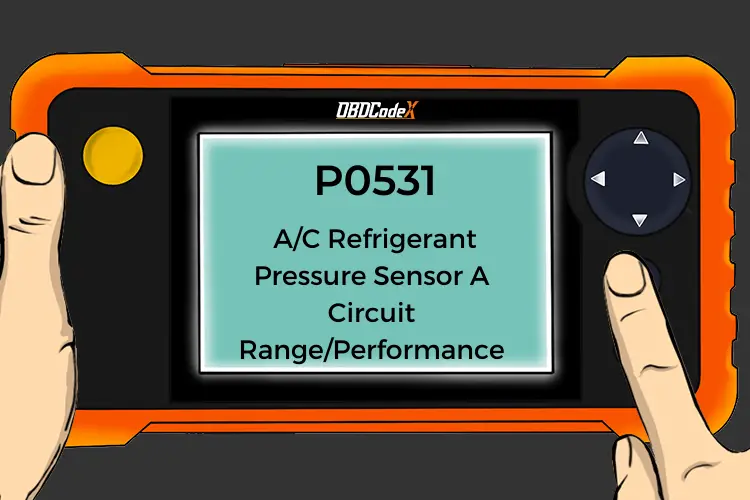P0533: A/C Refrigerant Pressure Sensor A Circuit High
Is your scanner showing P0533?
No worries. We'll show you what it means and how to deal with it.
P0533: A/C Refrigerant Pressure Sensor A Circuit High
OVERVIEWWhat Does The P0533 Code Mean?
The air conditioning (A/C) refrigerant pressure sensor aids in assisting the HVAC (Heating, Ventilation and Air Conditioning) system in regulating the temperature inside the vehicle according to your demands.
The BCM (Body Control Module) or the ECC (Electronic Climate Control) Module monitors the sensor to determines system pressures, in turn can engage/disengage the compressor accordingly.
The A/C refrigerant pressure sensor is a pressure transducer, it converts refrigerant system pressure to analog electrical signal to allow for monitoring by the vehicle’s modules. Typically, it does this using 3 wires: a 5 volt reference wire, signal wire and a ground wire. The modules compare the signal wire’s values to the 5 volt reference, and can instantly calculate system pressures with this info.
The ECM (Engine Control Module) illuminates the MIL (Malfunction Indicator Lamp) with P0533 and associated codes (P0530, P0531, and P0532) when it detects a fault within the A/C refrigerant pressure sensor or it’s circuits. Before doing any kind of diagnosing and/or repairing within the A/C, you must make sure you are aware of the numerous hazards involved in working with pressurized refrigerant. Most times, you can diagnose this type of code without opening the refrigerant system.
The code P0533 A/C Refrigerant Pressure Sensor A Circuit High is set when one of the modules monitors a high electrical value within the A/C refrigerant pressure sensor A or it’s circuit.
What Are The Symptoms Of The P0533 Code?
Symptoms of a P0533 diagnostic code may include:
- Inaccurate temperatures coming from fan air
- Limited HVAC use
- Fan air temperature erratic/fluctuating
- A/C compressor not engaging when needed
- HVAC system operating abnormally
What Are The Potential Causes Of The P0533 Code?
Causes for this P0533 code may include:
- Defective or damaged A/C refrigerant pressure sensor
- A/C refrigerant pressure sensor leaking
- Low or incorrect refrigerant pressures/refrigerant level
- Damaged wire(s) (open,short to +, short to -, etc.)
- Damaged connector
- ECC (Electronic Climate Control) or BCM (Body Control Module) issue
- Poor connections
How Serious Is This P0533 Code?
In my opinion, any HVAC related code’s severity will be fairly low. In this case, pressurized refrigerant is involved, it may be more of a pressing issue. Who knows, a refrigerant leak may be causing this code, and leaking refrigerant is definitely a hazard so make sure you have some basic refrigerant safety knowledge before attempting any type of repairs on the A/C system.
How Can You Fix The P0533 Code?
Prior to beginning the troubleshooting process for any malfunction you should research the Technical Service Bulletins (TSB’s) for the specific vehicle by year, model and transmission. This step can save you time and money during diagnosis and repair!
Basic Step #1
Depending on what tools/knowledge you have access to, you can easily verify the A/C refrigerant pressure sensors operation. The 2 easy ways to do this is:
1. Depending on your OBD reader/scan tool’s abilities and limitations, you may be able to monitor refrigerant pressures and other desired values while system is operating to verify the sensor’s functionality.
2. If you have a A/C manifold gauge set, you can monitor the pressures mechanically and compare pressures with your manufacturer’s specific desired values.
TIP: If you have no experience with refrigerant, I wouldn’t recommend diving into pressure testing so make sure you aren’t in over your head here, refrigerant is a hazard to the environment so its not something to mess around with.
Basic Step #2
Test the A/C refrigerant pressure sensor. As I mentioned earlier, most times, this sensor is a 3-wire pressure transducer. That being said, testing it will involve testing between the pins and recording your findings. The desired values of this test varies a meaningful amount between manufacturers, temperatures, type of sensor etc,, so make sure your info is accurate.
NOTE: Make sure you are using the appropriate test pins along with your multimeter when testing pins/connectors. a damaged pin or connector could cause future intermittent hard- to-find electrical gremlins.
Basic Step #3
Check the wiring. Sometimes these sensors will be mounted on a A/C pressure line or close to a line connection so the harness will be routed accordingly. I’ve personally seen these sensors damaged by moving parts under the hood because the line was not secured correctly. Make sure the sensor looks good physically and the line is fastened adequately.
Recommended Parts
Below are some recommended auto parts to help you address the trouble code affecting your vehicle and get it running smoothly again:
Note: During the purchasing process, please check carefully whether the part you want to buy fits your car!
Reference Sources
P0533 A/C Refrigerant Pressure Sensor A Circuit High, OBD-Codes.








